| Conservation of the Jaffa Gate Section |

|
The Jaffa Gate section, between Jaffa Gate and the northwestern corner of the city walls (Zahal Square), was constructed on top of the eastern bank of the Ben Hinnom Valley. On the inside of the wall are buildings belonging to the Latin Patriarchate and College des Freres. This segment of the wall can be easily seen from Yemin Moshe neighborhood and Mamilla, from King David Street and the Wall Builders Garden.
Physical Data
There are fourteen segments c. 285 meters long in the Jaffa Gate section. The outside of the city wall is c. 13 meters high and the towers reach a height of c. 14 meters. In this section the wall's exterior facade covers an area of approximately 4,205 square meters. The elevation of the city wall at the northwestern corner of the section is c. 782.70 meters above sea level.
Conservation Values
Historical Values. The different changes that have taken place over the course of time are reflected in the Jaffa Gate section. Remains of ancient city walls from the Hasmonean period and the Ayyubid period are incorporated in the Ottoman city wall. In addition, one can see signs of where the Late Ottoman buildings were attached to the outside of the city wall (Fig. 1).
Fortifications from the Jordanian period, which were hastily built of concrete and fieldstones, were preserved and they constitute a tier in the history of the city wall monument. A last memory dating from the War of Independence is apparent on the wall, in the wake of which numerous bullet holes were left around the firing slits and crenellations. These are evidence of the fierce battles that took place there during that conflict.
Urban Values. The location of the Jaffa Gate section, which faces west in the direction of the New City, and its considerable height relative to its surroundings, have created a high level of visibility. This section is a traffic route that is busy all hours of the day, thanks to Jaffa Gate, which serves as an entrance to the city from the west, used by both vehicles and pedestrians.
Architectural Values.The skyline of the Jaffa Gate wall is visible in its entirety and was preserved due to its considerable height. The towers in this section appear at set intervals. The Ottoman city wall was built on top of previous walls with meticulous technology, whereas the coarsely finished construction of the Ayyubid wall is characterized by the use of crudely dressed stone fragments. The Ottoman wall above it is distinguished by its delicate stone dressing and thin joints.
Physical Problems
The level of preservation along the section was not uniform. Since 1967 the Jerusalem municipality and Department of Antiquities have treated the city wall numerous times. In the lower parts of the wall the joints were pointed up with cement. This standardized manner of intervention covered up the technological differences between the different periods of the wall.
The state of preservation on the inside of the wall is reasonable, except in places where the intervention was unsuitable. It was apparent that capers have taken root in the wall's crenellations; a railing that had been installed at the time of the British Mandate caused significant cracking in the stone; on the outside of the wall there was massive stone deterioration as a result of a fire in the region where nearby buildings once stood.
The Jordanian walls were in a dilapidated condition: mortar was missing; stones were detached and there was cracking in the coping that sealed the top of the wall and in the lintel stone of the northern opening in the tower.
Jordanian Fortifications. During the Jordanian period a defensive position was built in the tower next to the Jaffa Gate. The walls were built perpendicular to the city wall and turned the roof level of the tower into an observation point and firing position. The walls of the Jordanian fortifications were rickety and unstable due to the lack of mortar and cracking in the lintel of the doorway in one of the walls. Since they are historical remains of the Jordanian defensive positions and due to their strategic location in the wall, it was decided to conserve the Jordanian fortification walls as evidence of this period.
The Conservation Measures
The Wall's Foundations. The treatment of the remains of the ancient walls included: removing vegetation, stabilizing loose stones, pointing up the joints with mortar and adding stone wedges (klinim) in accordance with the original building technology, and injecting lime-based mortar into the core of the wall.
The Wall's Facades. With the erection of scaffolding along the outer face of the city wall, numerous stones were discovered that suffered from severe weathering as a result of a fire in the region where buildings once stood next to the wall. These stones were apparently damaged by the fire that took place in the buildings. Pieces of crumbling stone were removed and the stones were stabilized by means of mortar (Figs. 2, 3). On the inner face of the wall, close to the College des Freres courtyard, stones were stabilized that were in danger of becoming detached. In contrast, in the northern part, where the wall is located in an area owned by the Latin Patriarchate, this problem could not be addressed owing to difficulties encountered when trying to coordinate the treatment with the patriarchy. The buildings that were constructed alongside the western wall and were dismantled during the British Mandate left gouged marks in the stone courses in the wall. These gouges, for the purpose of anchoring the buildings to the city, were preserved as evidence of those structures. The gouged area on the surface of the stone was sealed so as to prevent the penetration of water, and the remnants of the original mortar of the later buildings were preserved (Fig. 4).
Vault Cavities on the Inside of the Wall near Jaffa Gate. Significant cracking was noted in the vault cavities, which undermined the stability of the cavity. The cracking was treated by means of installing anchors and closing the cracks with lime-based mortar (Figs. 5, 6).
Sealing the Upper Sentry Post. The upper sentry path suffered from sealing problems and vegetation taking root along the entire length of it. The treatment of the problems in this region was local and provided for sealing the stone floor without removing all of the vegetation.
Vegetation Taking Root in the Crenellations.Damaging vegetation that had taken root in the stone courses of the city wall and the crenellations was manually removed and treated by means of an herbicide. Some of the wall's crenellations that suffered from vegetation growing in them had to be dismantled in order to extract the roots from them. Afterwards, they were rebuilt and the joints were re-pointed, and the tops of the crenallations' walls were sealed in order to prevent vegetation from taking root there again.
Jordanian Fortifications. The walls were stabilized by means of mortar that matched the color of the mortar used in the Jordanian construction. The top of the wall that was unstable was dismantled and rebuilt using lime-based mortar. A cracked lintel of a doorway was replaced with a new stone; here we had to dismantle parts of the wall and rebuilt it (Figs. 7, 8).
Mandatory Handrail. During the British Mandate handrails and hand holds were installed between the stones in the wall. These caused cracking and allowed vegetation to take root due to the development of rust from the penetration of water. The cracking was treated by means of filling it with lime-based mortar. In several instances it was necessary to dismantle the pavement, remove the vegetation and rebuilt the pavement (Figs. 9, 10).
|
|
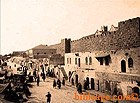
|
| 1. The wall's facade north of Jaffa Gate and the buildings adjacent to it at the end of the nineteenth century. |
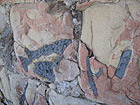
|
| 2. Stone deterioration as a result of a fire, 2009. Photograph: Yuval Abraham. |
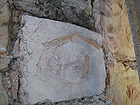
|
| 3. The surface of the stabilized stone and the treatment of the stone deterioration, 2009. Photograph: Yuval Abraham. |
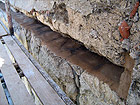
|
| 4. Sealing the gouging in the wall, 2009. Photograph: Yuval Abraham. |
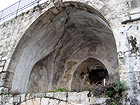
|
| 5. The cracked vault cavity prior to conservation, 2009. Photograph: Yuval Abraham. |
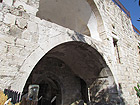
|
| 6. The vault cavity after conservation, 2012. Photograph: Yuval Abraham. |
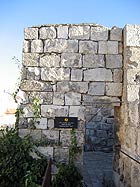
|
| 7. The northern facade of the northern wall in the Jordanian tower - before, 2009. Photograph: Yuval Abraham. |
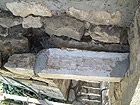
|
| 8. The northern wall of the Jordanian tower after dismantling and the installation of a new lintel stone, 2009. Photograph: Yuval Abraham. |
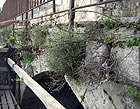
|
| 9. Cracking and vegetation that took root in the vault arch, near the Mandatory handrail, prior to conservation, 2009. Photograph: Yuval Abraham. |
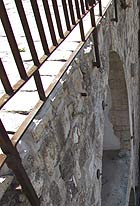
|
| 10. The vault arch after conservation, 2012. Photograph: Yuval Abraham. |
|















